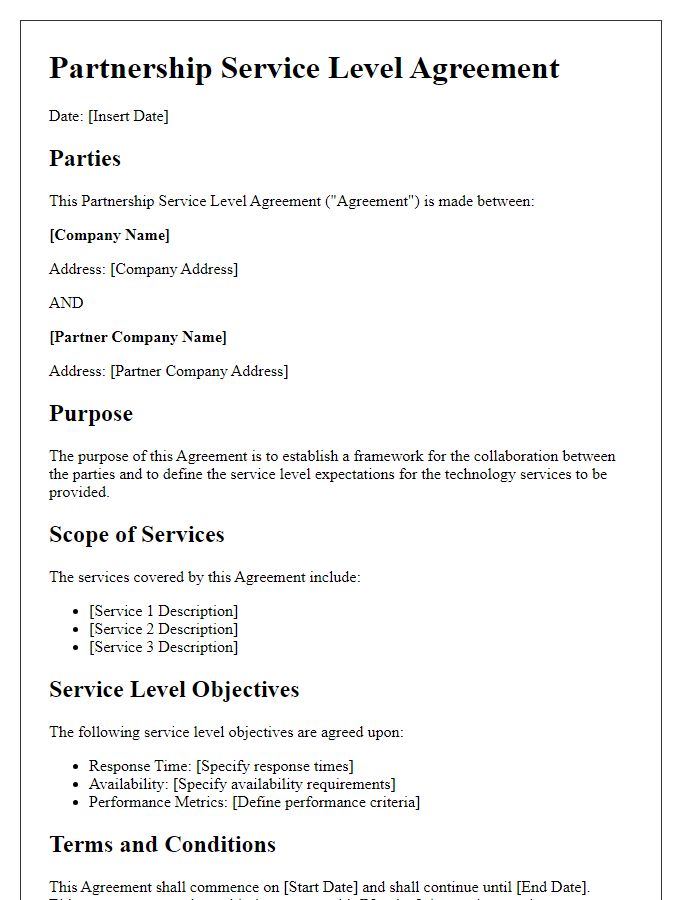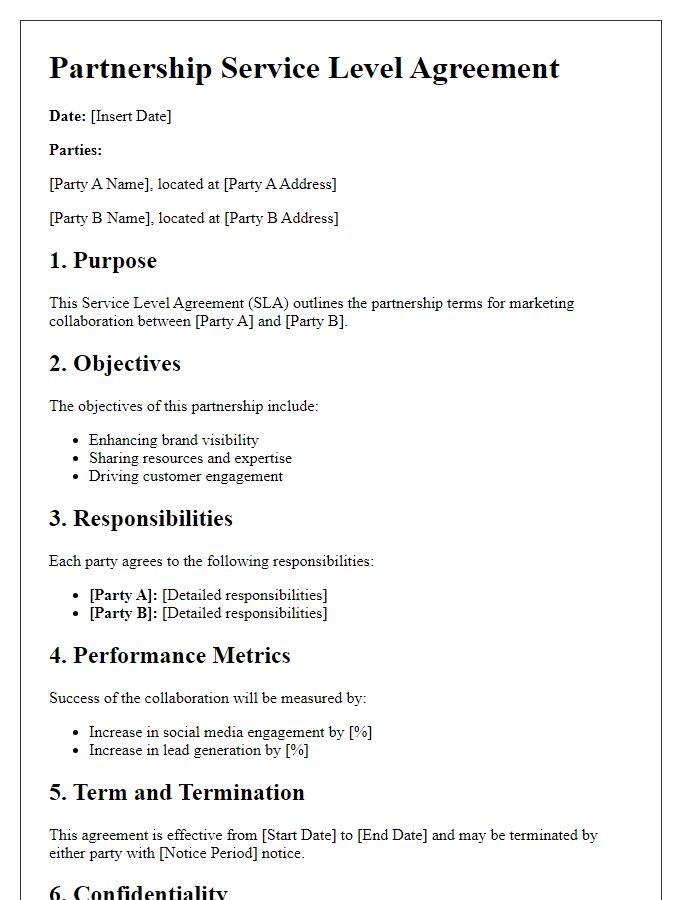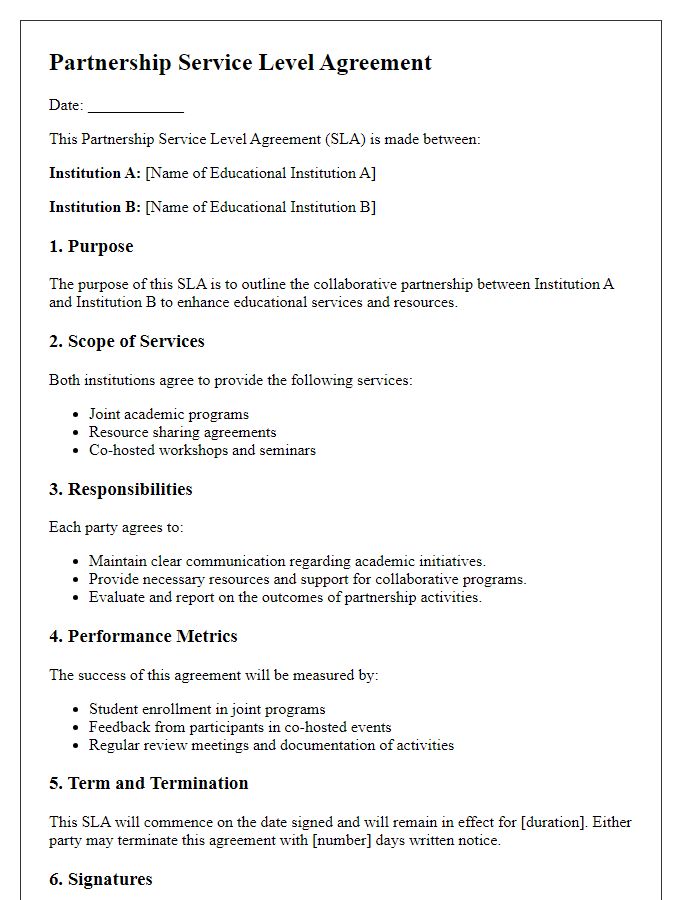Are you looking to establish a strong foundation for your business collaboration? Crafting a well-structured service level agreement (SLA) is essential for ensuring both parties understand their roles and responsibilities. This template will guide you through the important elements to include in your partnership SLA, promoting transparency and mutual respect. So, let's dive in and explore how this agreement can set the stage for a successful partnership!

Clear Definition of Services
A well-defined Service Level Agreement (SLA) outlines the specific services provided within a partnership, ensuring that both parties have a mutual understanding of expectations. This document typically includes the scope of services, detailing the functionalities or tasks expected, such as technical support, maintenance schedules, and response times. It specifies performance metrics, such as uptime percentage, which may target over 99.9% for critical applications, and communication protocols, including reporting methods and frequency. Additionally, service definitions address the roles and responsibilities of each party, ensuring accountability in operations. Terms governing issue resolution and escalation processes are also critical, specifying how disputes will be handled and establishing clear pathways for addressing service failures. This framework is essential for fostering a productive partnership and aligning service delivery with business objectives.
Roles and Responsibilities
Service Level Agreements (SLAs) define the roles and responsibilities of partners in a business context. Each party must outline specific functions, including service delivery expectations, performance metrics, and response times. The managing partner is responsible for coordinating with stakeholders, ensuring compliance with guidelines, and addressing service disruptions. The support partner provides technical assistance, maintains service uptime (typically 99.9%), and communicates service issues promptly. Both partners must engage in regular performance reviews to evaluate compliance with agreed-upon metrics, such as incident response times, which commonly sit at a maximum of two hours for critical issues. Clear documentation of each partner's obligations fosters collaboration and accountability in achieving shared goals.
Performance Metrics and Monitoring
Effective partnership service level agreements (SLAs) establish clear performance metrics for evaluating service provider actions. These metrics typically include key performance indicators (KPIs) such as response time (e.g., average response within 2 hours for critical issues), resolution time (e.g., 95% of issues resolved within 24 hours), and service availability (e.g., 99.9% uptime for online platforms). Monitoring mechanisms such as weekly reports, dashboard tools like Tableau or Power BI, and monthly review meetings in defined locations enhance accountability and allow for adjustments based on service performance. Regular audits (quarterly or bi-annually) can ensure compliance with the agreed-upon standards, fostering continuous improvement and strengthening the partnership.
Communication Protocols
Effective communication protocols are essential for maintaining collaboration in a service-level partnership. Clear definitions (such as what constitutes an emergency or routine communication) help ensure that parties interact efficiently. Scheduled meetings (weekly check-ins) can foster proactive problem-solving, while designated communication channels (email, instant messaging) enhance response times. Documentation of all communications facilitates accountability and supports conflict resolution when necessary. Furthermore, escalation procedures should be outlined to address unresolved issues promptly, ensuring that both parties can maintain a productive and transparent relationship throughout the partnership.
Dispute Resolution Process
A partnership service level agreement (SLA) outlines a clear dispute resolution process essential for maintaining a healthy business relationship. Typically, it begins with a defined procedure for identifying and documenting disputes, which usually occurs through formal communication channels, such as emails or dedicated platforms by specific representatives from both parties. The process may involve an initial internal review phase, lasting up to ten business days, allowing each party to present their perspectives. If unresolved, mediation with a selected third-party mediator experienced in dispute resolution can occur. This step usually takes place within 20 business days, providing a structured approach to finding mutually agreeable solutions. If mediation fails, the final resolution stage could involve arbitration, conducted according to agreed-upon rules, and held at neutral locations, usually governed by organizations like the American Arbitration Association, ensuring fairness and confidentiality.
Letter Template For Partnership Service Level Agreement Samples
Letter template of Partnership Service Level Agreement for Technology Services

Letter template of Partnership Service Level Agreement for Marketing Collaboration

Letter template of Partnership Service Level Agreement for Logistics Support

Letter template of Partnership Service Level Agreement for Educational Institutions

Letter template of Partnership Service Level Agreement for Healthcare Partnerships

Letter template of Partnership Service Level Agreement for Software Development

Letter template of Partnership Service Level Agreement for Research and Development

Letter template of Partnership Service Level Agreement for Event Management Services

Letter template of Partnership Service Level Agreement for Consulting Services





Comments